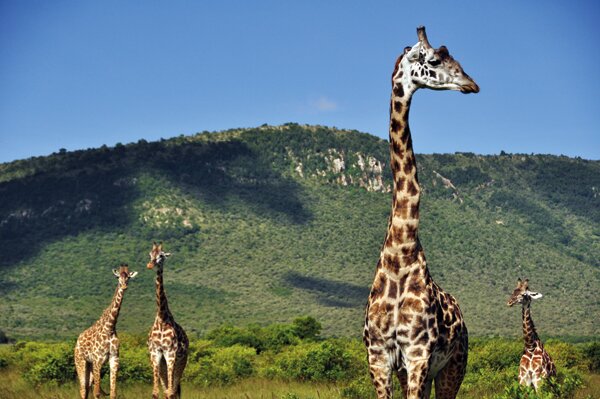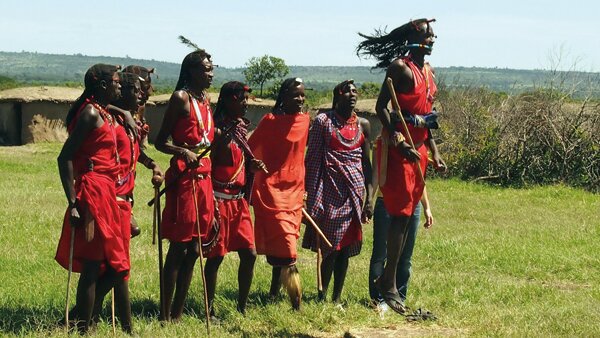Escape the hectic modern world on an unforgettable safari through the wild plains of Africa
An African safari should be on every traveller’s bucket list and few are as impressionable as Masai Mara. Named after the indigenous people – the Maasai – who still inhabit the area, and the local word for spotted – Maa – visitors are taken on a guided adventure through the unspoilt grasslands of Africa.
Located in southwestern Kenya, the Masai Mara was originally established in 1961 as a 520 square kilometre wildlife sanctuary. By 1984 the reserve had been given national park status and was increased to include 1,510km2 of land. Today, the Masai Mara is only a small section of the impressive 25,000km2 Mara-Serengeti ecosystem, which crosses the border into Tanzania.
Teeming with wildlife from big cats, Masai giraffes and the spotted hyena to marabou storks, elands and bat-eared foxes, the national reserve is renowned for its astounding nature. The local safari drivers are brimming with passion and infinite knowledge of the nature that surrounds them and have an uncanny ability to spot the tip of a cheetah’s tail from several valleys away. There is no better way to enjoy nature than to see such majestic animals in their natural environment – and from the safety of your vehicle.
As you drive around the vast plains, keep your eyes peeled for the big five: the lion, leopard, African buffalo, black rhinoceros and African elephant. The critically endangered black rhino is showing slow signs of population increase thanks to poaching restrictions while the leopard is an infamously elusive night hunter, so consider yourself lucky if you spot either of these.
Sharing a border with Serengeti National Park in Tanzania, the Masai Mara is the famous site of the Great Migration – the annual move of wildebeest to and from the Serengeti from July to October. This is a popular time to book a safari, although some may prefer to avoid this peak season swarm. December to February is a drier time and considered a good opportunity to spot big cats.
Activities
A trip to the Mara wouldn’t be complete without a visit to a local Masai manyatta (village) or a hot air balloon ride over the bush.
While wildlife is at the heart of a safari holiday, the local tribes can also leave a lasting impression. Tourists are welcome to have a tour of local villages at an arranged time to experience what life is like in the bush. Learn how to light a spark for the fire, perform the traditional Maasai warrior dance and shop for colourful handmade beaded trinkets. While these trips are paid for, your guide may also suggest you give a small donation to help the village pay for education, clothing and supplies.
If you think the Masai Mara looks impressive from the seat of your safari car, wait until you see it from the air. A balloon safari at dusk is a magical way to see the African plains and gives a better vantage point for spotting wildlife. Skim over baboon-infested trees, follow a lioness as she makes a kill and glide safely over a lazy sunbathing crocodile. Many balloon rides end with an unforgettable bubbly breakfast in the bush to round off the morning. We recommend Skyship Company, which offers tours for AED 1,763 per adult. For more information, visit: www.skyshipcompany.com
Accommodation
As a major tourist attraction for Kenya, the Masai Mara is naturally home to a number of accommodation sites. Whether you are looking for a tented camp or luxury lodge, it is worth putting some research into your options.
For those looking to go all out, Fairmont Mara Safari Club offers the ultimate Mara experience. Greeting guests at the runway strip with a towel and refreshment, the local staff make you feel welcome from the get go. The resort is traditionally decorated but has been given a modern edge with a majestic main lodge, poolside massage facilities and luxury ‘tent’ accommodation. Surrounded on three sides by the Mara River, guests can fall asleep to the sounds of wallowing hippos, take a walk with the resident chameleon and keep their eyes peeled for the sneaky but curious galago (bush baby). The hotel also offers other activities including walking safaris, bird tours and fishing trips. To find out more, visit: www.fairmont.com/masai-mara-safari
Because of the vast amount of wildlife to be seen, it is recommended that guests stay for at least three days. However, if you are a keen photographer or just want to switch off from the modern world, you may find yourself in the Mara for months.
Getting there
The journey to the Masai Mara is almost as exciting as the destination itself. While many major airlines, including Etihad Airways, fly direct to Nairobi, Air Kenya flies daily from Nairobi’s Wilson airport to nine airstrips in the Mara. Not a trip for the fainthearted, a small plane (and we mean small) carries a handful of passengers at a time for a bumpy ride over the bush. It may be a rough flight, but the aerial view over the Mara offers visitors an exciting sample of what’s to come.
Depending on where you will be staying, each hotel or camp will have its own designated dirt runway strip from which to collect its guests. Your hotel should be able to advise you on this when you book.
To split up the journey, many travellers favour a stop over in Nairobi, known as the ‘green city in the sun’. Various international hotel brands have properties in the capital including Fairmont – The Norfolk Hotel, Crowne Plaza Hotel Nairobi and InterContinental Nairobi. While there, visit the Nairobi Java House, the Kenyan version of Western high street cafes such as Starbucks and Costa Coffee. Kenya is well known for its mild Arabica blends that are mostly grown by small-scale holders across the country. Remember that as a tourist, you may be targeted by scammers; some may offer to take you to a shop while others claim to be collecting money for sick children.
Making memories
A picture is worth a thousand words. So be sure to take a good quality camera with you on your safari, as well as a pair of binoculars to catch a closer glimpse of that elusive leopard. The guides and drivers will regularly stop the vehicle as close to the wildlife as is safe to do so, allowing you to get some great shots.
In the media
The BBC show ‘Big Cat Diary’, which follows the lives of resident big cats, was filmed in the Masai Mara.
The 1985 Academy Award-winning blockbuster ‘Out of Africa’, starring Robert Redford and Meryl Streep, was filmed near the foot of the Ngong Hills overlooking the Nairobi National Park.




























